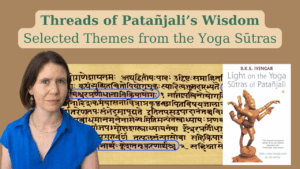
From Book Session: Unit 4 of Geeta Iyengar's Yoga a Gem for Women Basic Asana-s
In “Yoga – A Gem for Women,” Geeta S. Iyengar introduces Virabhadrasana as a powerful sequence of poses, each with increasing intensity. The asana, named after the fierce warrior Virabhadra, embodies both physical prowess and spiritual significance, beautifully bridging ancient sacred narratives with contemporary practice. If you’re curious about how other poses bridge myth and practice, read about Sarvangasana – The Jewel of the Three Worlds.
Geeta Iyengar describes the pose with characteristic precision. For Virabhadrasana I, she instructs: “While exhaling, bend the right knee to 90°. Take the head back and look up at the thumbs.” She emphasizes the importance of proper alignment, noting that “both the pelvic bones should be parallel to each other, facing forwards and should not tilt to the side.”
The sequence progresses through three variations, each demanding greater strength and balance. As Iyengar notes, “The expansion of the chest makes the breathing deep. The posture relieves stiffness in the shoulders and strengthens the legs. By taking the head back, the neck is extended and the thyroid and the parathyroid glands are massaged.”
The pose’s name carries profound spiritual significance. Virabhadra, created from Shiva’s grief and rage upon learning of his beloved wife Sati’s death, emerged as a formidable warrior with a thousand arms, three fiery eyes, and immense power. This sacred narrative adds layers of meaning to the practice, connecting the physical posture to themes of transformation, justice, and devotion.
The story of Virabhadra is rooted in the narrative of Shiva and Sati, a powerful tale from Hindu sacred literature that reflects complex theological and cosmological themes—devotion, honor, cosmic justice, and the nature of divine anger. This story is found in several Sanskrit sources, including the Skanda Purāṇa, Harivaṃśa, and Kūrma Purāṇa, and remains central to both the Shaiva tradition and the symbolic landscape of yogic practice.
Sati, the daughter of Dakṣa Prajāpati—a progenitor and one of Brahmā’s mind-born sons—married Śiva against her father’s wishes. Dakṣa, a staunch upholder of Vedic orthodoxy and social hierarchy, viewed Śiva as an outsider to established norms: an ascetic god who dwelled in cremation grounds, smeared in ash, adorned with serpents, and often accompanied by spirits and goblins. Although Sati chose Śiva with deep devotion, Dakṣa harbored resentment and disdain for the god, considering him unworthy of inclusion in the rituals of the divine elite.
In an act of public humiliation, Dakṣa organized a grand yajña (sacrificial ritual) to which all gods and sages were invited—except Śiva and Sati. Despite the slight, Sati resolved to attend the ritual, hoping to confront her father and defend her husband’s honor. However, upon her arrival, she was subjected to further insult and witnessed her father’s continued derision of Śiva. Overcome with grief and shame, and unable to bear the dishonor done to her lord, Sati renounced her familial ties and self-immolated in the sacrificial fire. Her death was not merely a personal tragedy but a cosmic rupture, as it signified the violation of dharma through arrogance and the desecration of the sacred marital bond.
Śiva’s response to Sati’s death was one of profound sorrow that quickly transformed into rage. In a moment of grief-stricken wrath, he plucked a lock of his matted hair and hurled it to the ground. From this act emerged Virabhadra, a fierce, anthropomorphic emanation created for the sole purpose of avenging Sati’s death and destroying the sacrificial ritual that had defiled the moral order. Virabhadra, described in vivid and terrifying terms across various sources, represents the embodiment of divine anger unleashed upon the cosmos when righteousness is violated. If you enjoy mythological stories and their link to yoga, you’re invited to watch my lecture on Teacher-Student Relationships.
The Puranic accounts portray Virabhadra as a towering and formidable warrior figure, whose appearance is meant to instill dread. His form is immense, often said to darken the heavens, with hair ablaze and eyes like fire. He is commonly endowed with multiple arms, each bearing deadly weapons such as the trident, mace, sword, and shield. His presence is both chaotic and purposeful: he is a force of destruction, yet not of randomness, for he acts under Śiva’s command and in service of restoring cosmic balance.
At Dakṣa’s yajña, Virabhadra arrived with a host of Śiva’s ganas (attendants), wreaking havoc upon the ritual and engaging in combat with the gods who had silently witnessed Sati’s humiliation. The ritual vessels were shattered, the priests were defeated, and finally, Virabhadra seized Dakṣa and severed his head. This act marked both the culmination of divine retribution and a symbolic beheading of pride and ego. Yet Śiva’s wrath eventually subsided, and through the intercession of the gods, Dakṣa was revived—albeit with the head of a goat—symbolizing his transformation and newfound humility.
☕ This kind of storytelling takes time, research, and love. If you’d like to support my work, you can Buy Me a Chai – and help keep these teachings flowing freely.
Virabhadra, though a being of destruction, is not portrayed as evil. Rather, he is a manifestation of divine justice, summoned in moments when the world has veered from its righteous path. His story illustrates the limits of ritual purity when severed from humility and devotion, and it cautions against the arrogance of institutional authority when it disrespects the sacred.
The figure of Virabhadra thus serves as both a sacred reminder of the consequences of disrespecting the divine and a symbol of righteous action aligned with higher purpose. His narrative, like much of Shaiva tradition, juxtaposes fury and compassion, destruction and renewal, reminding practitioners that the path to transformation often involves facing what has been broken before healing can occur.
Just as Virabhadra arose from intense emotion to restore cosmic balance, the pose challenges practitioners to find strength, balance, and dignity in moments of intensity. Each variation of Virabhadrasana engages different aspects of this warrior energy:
Virabhadrasana I: Iyengar emphasizes the upward reach and backward bend, reminiscent of the warrior’s first emergence.
Virabhadrasana II: The pose opens laterally, with Iyengar instructing practitioners to “stretch both the arms sideways as though they are being pulled apart in a tug-of-war,” embodying the warrior’s commanding presence.
Virabhadrasana III: The most challenging variation requires balance and strength, with Iyengar noting that “the body should be parallel to the ground from the fingers to the heel,” reflecting the warrior’s focused determination.
The physical demands of Virabhadrasana series serve a deeper purpose. As practitioners work with these challenging poses, they develop not just physical strength but also mental fortitude. Iyengar’s technical precision in describing the poses ensures that practitioners maintain dignity and proper alignment, qualities that characterized the noble warrior Virabhadra.
For those with physical limitations, Iyengar provides modifications: “Those who are weak and find it hard to straighten the arms may keep them apart.” This compassionate approach ensures that all practitioners can access the pose’s benefits while respecting their current capabilities.
Today, when many struggle with the challenges of modern life, Virabhadrasana offers lessons in standing one’s ground with dignity and purpose. The pose teaches us to face our challenges directly, maintain balance in difficult situations, and act with conscious awareness.
The warrior poses remind us that strength isn’t just about physical power – it’s about maintaining clarity, purpose, and proper alignment in body and mind. Just as Virabhadra arose to restore dharma (cosmic order), these poses help practitioners find their own inner strength and balance.
Through careful practice of Virabhadrasana, we connect to both the ancient wisdom of yoga and our own warrior spirit, learning to stand strong, move with purpose, and face life’s challenges with grace and dignity.
💡 Join my newsletter to receive more articles like this, plus invites to lectures, workshops, and the Yoga Readers global reading community.

A course of selected themes from the Yoga Sutras with Dr. Agi Wittich The Yoga Sūtras of Patañjali are the philosophical heart of yoga.

In a recent Yoga Readers session, Dr. Lois Steinberg opened her teaching archives and personal memories, sharing stories that span four decades of study
Agi Wittich is a yoga practitioner since two decades, and is a certified Iyengar Yoga teacher. Wittich studied Sanskrit and Tamil at the Hebrew University of Jerusalem, Israel, completing a PhD with a focus on Hinduism, Yoga, and Gender. She has published academic papers exploring topics such as Iyengar yoga and women, the effects of Western media on the image of yoga, and an analysis of the Thirumanthiram yoga text.